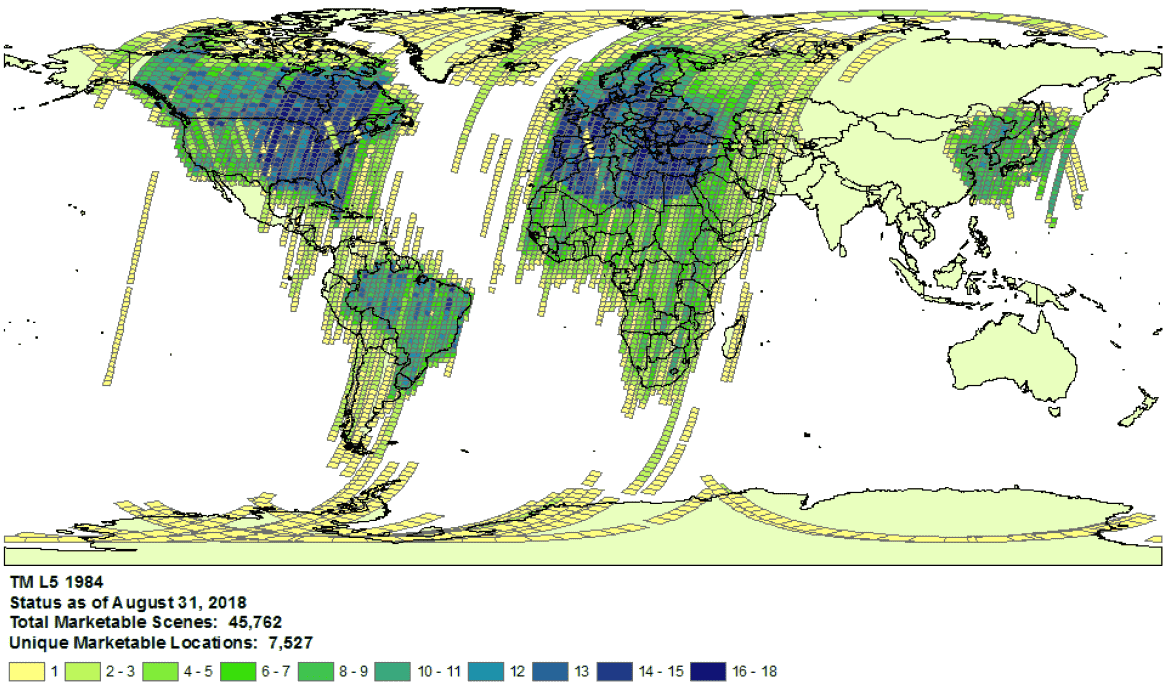Celem tego dokumentu jest pomoc w określeniu, czy w Earth Engine Data Catalog (obecnie Landsat, Sentinel i MODIS) brakuje jakiegoś zasobu.
Poniżej znajdziesz instrukcje, jak:
Sprawdź dostępne zasoby w katalogach Earth Engine i dostawców.
Zbierz informacje potrzebne do przesłania potwierdzenia braku zasobu do zespołu danych Earth Engine.
Najczęstsze kwestie do rozważenia
Poziom przetwarzania: w przypadku danego poziomu przetwarzania lub produktu mogą nie być dostępne wszystkie obrazy. Na przykład obrazy o niskiej jakości mogą nie zostać przetworzone na najwyższym poziomie.
Pokrycie czasowo-przestrzenne: regularna częstotliwość nie jest gwarantowana w przypadku każdego zbioru danych. Różnice w zadaniach wykonywanych przez czujniki, jakości obrazu i zarządzaniu archiwum mogą wpływać na dostępność danych dostawcy.
 Przykład zasięgu zbioru Landsat 5 w 1984 r.
Przykład zasięgu zbioru Landsat 5 w 1984 r.
- Wybór dostawcy: dane są przetwarzane w Earth Engine Data Catalog z wybranego dostawcy na podstawie zbioru danych. Możliwe, że dostawca nie oferuje pełnej archiwum misji. Na przykład zbiory danych Landsat są przetwarzane z archiwum USGS, w którym brakuje zdjęć z określonych stacji odbiorczych w określonych przedziałach czasu (więcej informacji znajdziesz w inicjatywie LGAC).
Landsat
Dane Landsat są przetwarzane z USGS.
Sprawdź dostępność danych Landsat w wybranym czasie i miejscu.
Przeprowadź wyszukiwanie w Earth Engine, aby uzyskać listę wszystkich zasobów dla wybranego czasu i obszaru. Upewnij się, że w Twoim kodzie nie zostały przypadkowo odfiltrowane żadne zasoby. Oto przykładowy skrypt. Pamiętaj, aby importować kolekcję z odpowiednim poziomem przetwarzania i poziomem (dowiedz się więcej o strukturze kolekcji Landsat).
Sprawdź, czy w katalogu USGS Earth Explorer nie brakuje Ci zasobów (szczegółowe instrukcje dotyczące wyszukiwania i wybierania zbiorów danych znajdziesz w przewodniku pomocy). Upewnij się, że porównujesz odpowiednie produkty i poziomy przetwarzania (zobacz strukturę kolekcji Landsat). Pamiętaj, że produkty dotyczące odbicia powierzchni są generowane tylko w przypadku obrazów Landsat na poziomie przetwarzania L1TP.
Udostępnij szczegółowe dowody braku zasobów, przesyłając formularz z identyfikatorem produktu dostawcy i linkiem do skryptu Earth Engine Code Editor potwierdzającym brak zasobów.
Sentinel
Dane Sentinela są przetwarzane z witryny Copernicus Dataspace.
Sprawdź dostępność danych Sentinela w określonym czasie i miejscu (patrz szczegóły misji).
Uwaga: produkty Sentinel-2 na poziomie 2A są systematycznie generowane w segmentach naziemnych w Europie od marca 2018 r., a w grudniu 2018 r. ich produkcja została rozszerzona na cały świat (więcej informacji znajdziesz w przewodniku użytkownika ESA). Ostatecznie zostaną one ponownie wygenerowane w ramach kolekcji 1.
Przeprowadź wyszukiwanie w Earth Engine, aby uzyskać listę wszystkich zasobów dla wybranego czasu i obszaru. Upewnij się, że w Twoim kodzie nie zostały przypadkowo odfiltrowane żadne zasoby. Oto przykładowy skrypt. Pamiętaj, aby importować kolekcję z odpowiednim poziomem przetwarzania.
Sprawdź, czy w katalogu Copernicus nie brakuje jakichś zasobów.
Udostępnij szczegółowe dowody braku zasobów, przesyłając formularz z identyfikatorem produktu dostawcy i linkiem do skryptu Earth Engine Code Editor potwierdzającym brak zasobów.
MODIS
Dane MODIS są pozyskiwane z Land Processes Distributed Active Archive Center (LP DAAC).
Przeprowadź wyszukiwanie w Earth Engine, aby uzyskać listę wszystkich zasobów dla wybranego czasu i obszaru. Upewnij się, że w Twoim kodzie nie zostały przypadkowo odfiltrowane żadne zasoby. Oto przykładowy skrypt. Upewnij się, że importujesz właściwy produkt.
Sprawdź, czy w zbiorze danych USGS nie brakuje zasobów, które nie zostały dodane do Earth Engine. Przejdź do odpowiedniego folderu i sprawdź, jakie najnowsze katalogi są dostępne.
Zbiory danych zaczynające się od „MOD” znajdują się w folderze „Terra MODIS”.
Zbiory danych zaczynające się od „MYD” znajdują się w folderze „Aqua MODIS”.
Zbiory danych rozpoczynające się od „MCD” znajdują się w folderze „Combined MODIS”.
Zbiory danych rozpoczynające się od „VNP” znajdują się w folderze „S-NPP VIIRS”.
Udostępnij szczegółowe dowody braku zasobów, przesyłając formularz z identyfikatorem produktu dostawcy i linkiem do skryptu Earth Engine Code Editor potwierdzającym brak zasobów.
